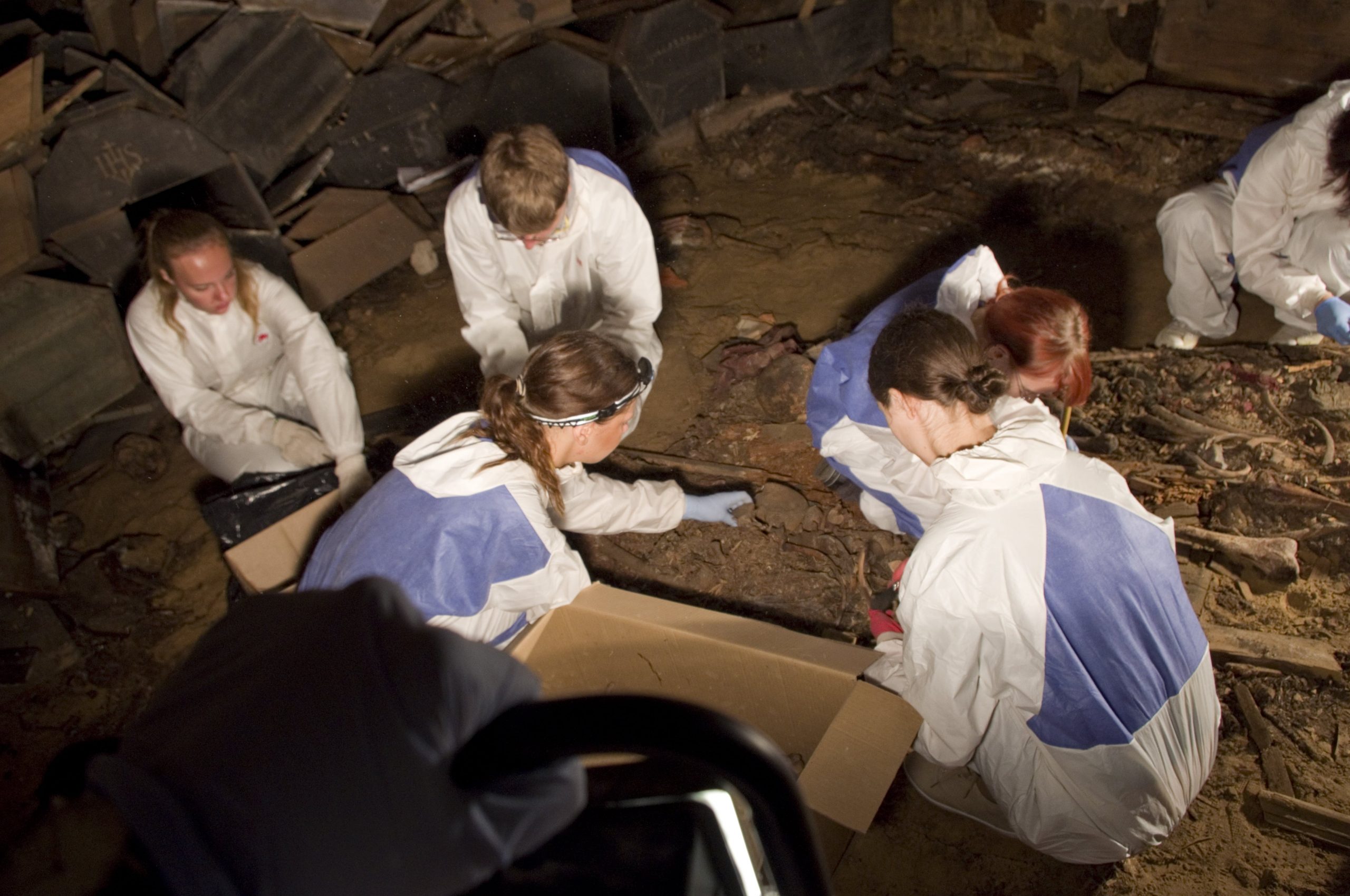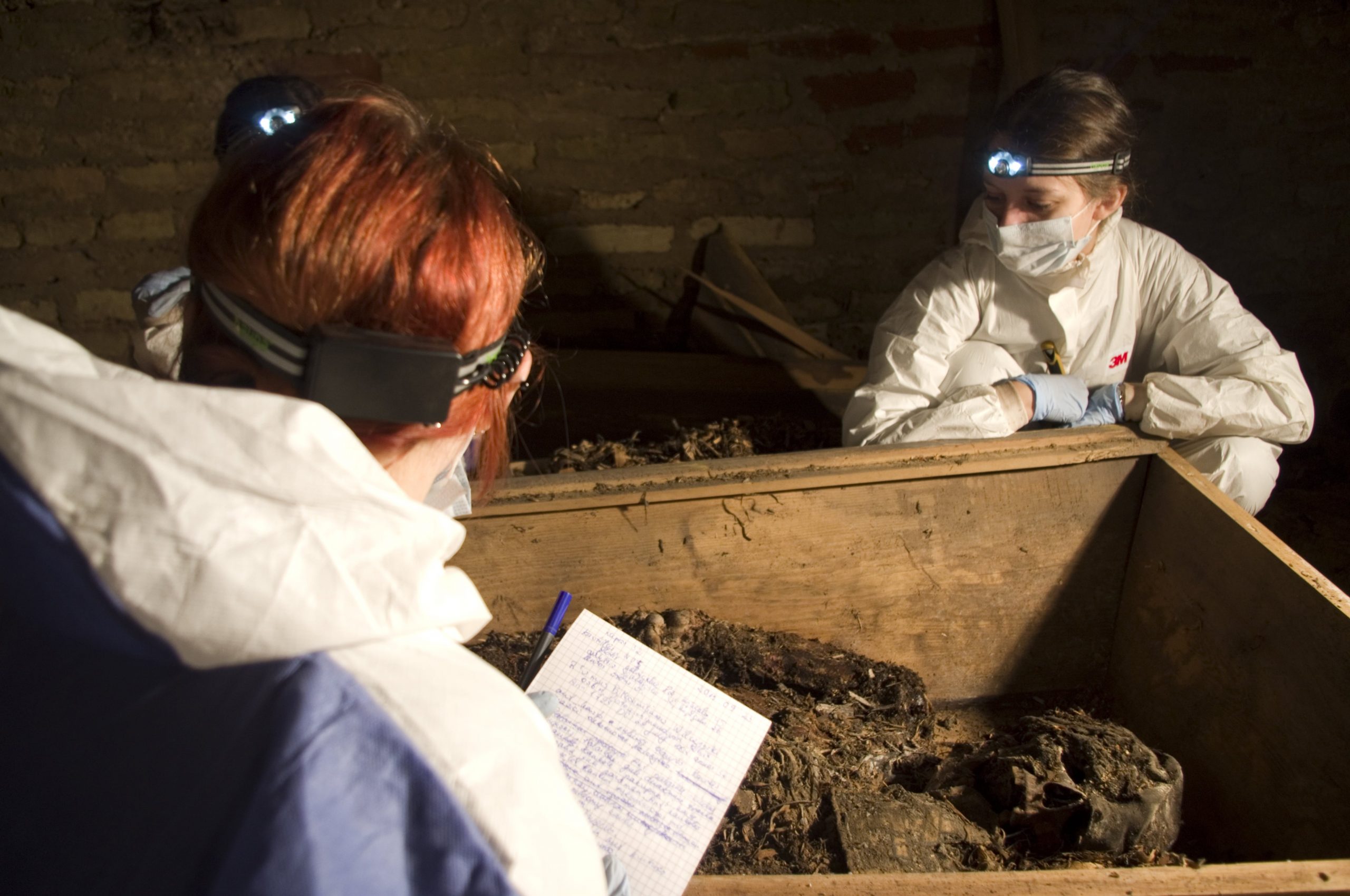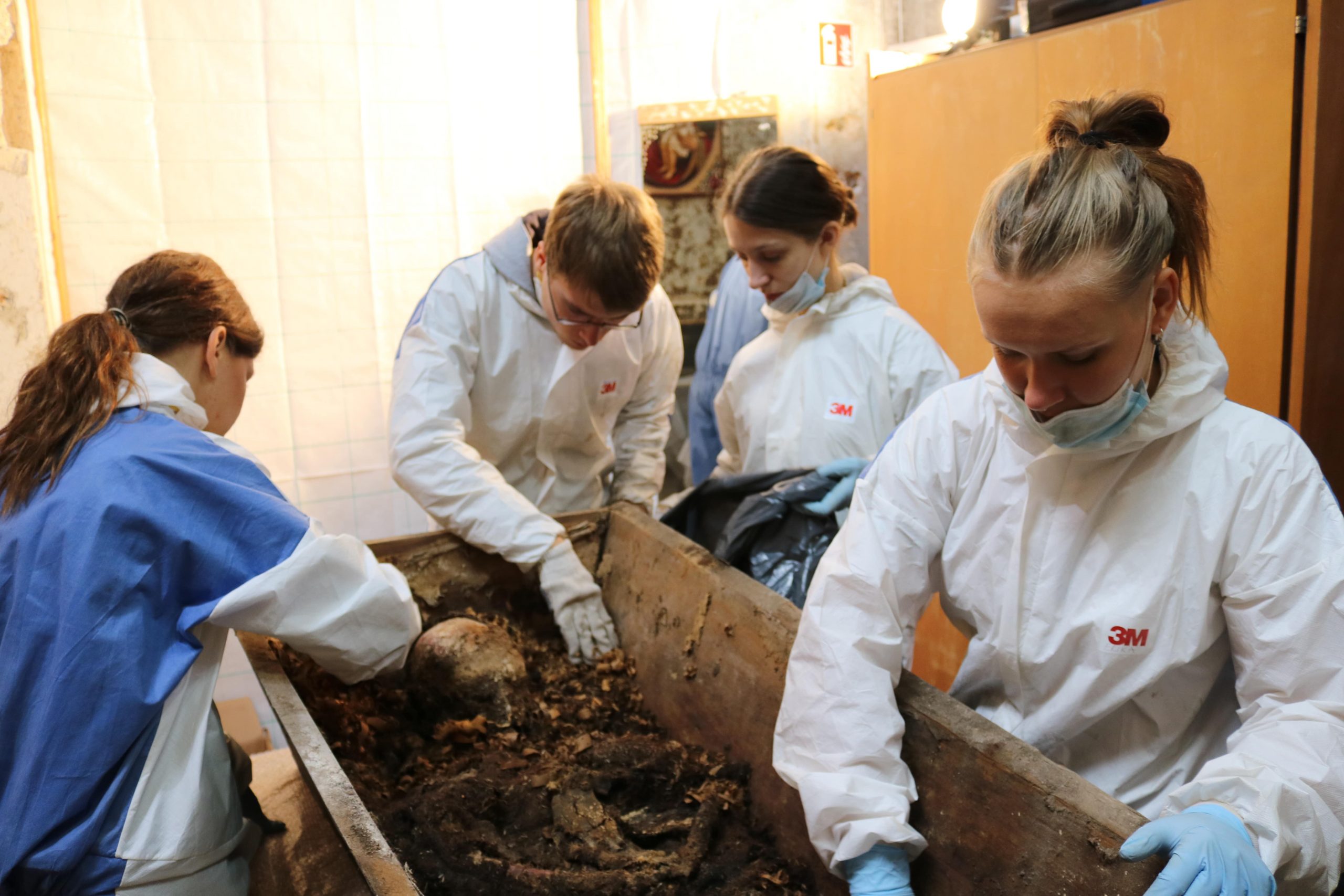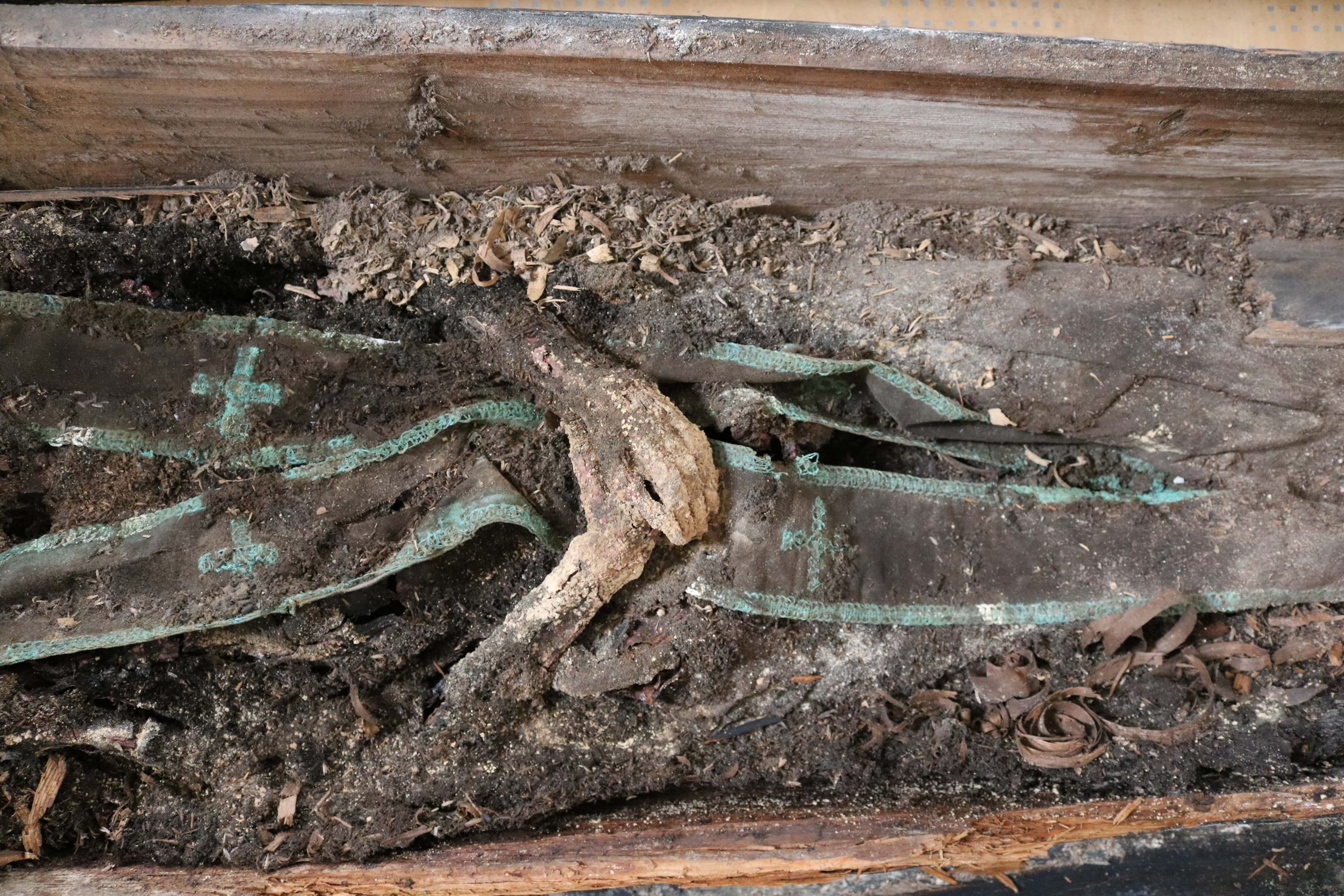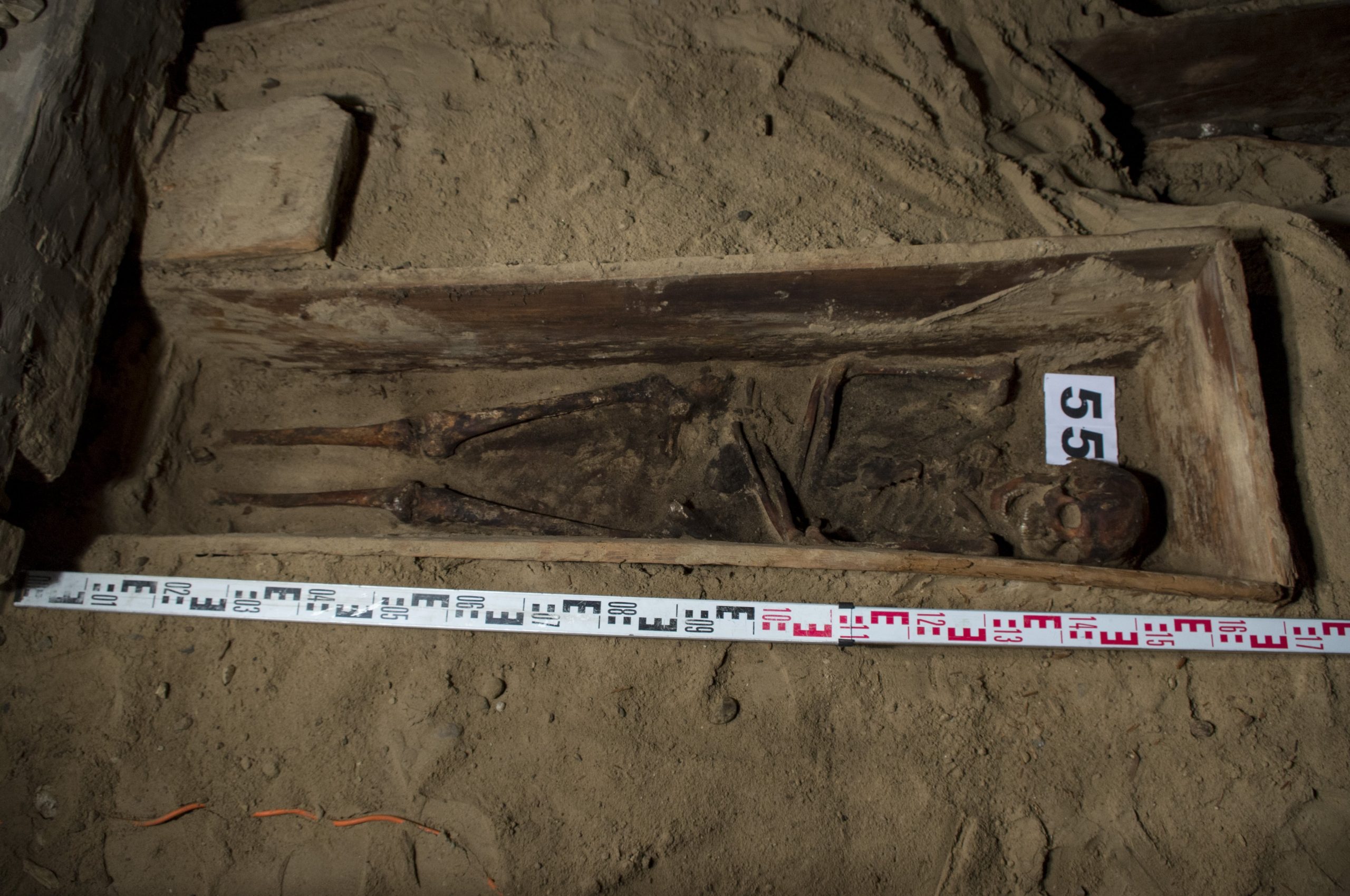Anthropological research of the remains discovered in 2015–2016 under the great altar of the Holy Trinity Church [1, 2, 3] allow us to better understand the manner of life of the Basilian monks in the 18th century (↑). In the crypt five mummies, 13 partially mummified bodies, and 56 skeletons were uncovered [4, 5]. It is considered that the mummification happened here in a natural way, thanks to a favourable microclimate (fairly constant temperature, dry air), without additional external interference. However, from among all the mummies, one is distinguished, as its stomach and breasts were filled with small wood chips. It is considered that the mummification of the bodies happened in a natural way, due to a favourable microclimate (like fairly constant temperature, and dry air), without additional external interference. However, one body contained traces of a possible embalming: individual’s stomach and chest cavities were open and filled with small wood chips. This particular case suggests that embalming was employed to slow down a body decay (as a rule, only the elite members were embalmed; however, the items placed with the discussed deceased do not indicate a noble origin). Unfortunately, more detailed research of this unique discovery was impossible, in order to avoid harming or destroying it.
Two female individuals were identified buried among males. Only two individuals were of undetermined sex – body decomposition and missing elements for sex determination impeded the thorough anthropological analysis. The two mentioned females died in their old years, having had, perhaps, a difficult last years of their life: no teeth and hunched backs.
Seventeen monks also left this world in their senior years (all of them were over 50 years and older). Diseases, so typical for senile people, were not kind to them: they had pain in their joints and spine damaged by arthritis, spinal hernias received from trauma or physical labor, and various inflammations. Another 10 males died at a young age, i.e. 20–29 years old; 25 lived to 30–39 years old; and 20 to 40–49 years old. It is difficult to determine the cause of death of each monk, though certain tendencies of their general health conditions could be unveiled. The living environment is one of the main determinants of the length of a person’s life. It is a well-known fact, that the most vulnerable to various unfamiliar pathogens that were prevalent in cities were children and new comers.1Rebecca Redfern, et al., “A Novel Investigation into Migrant and Local Health-Statuses in the Past: A Case Study from Roman Britain”, Bioarchaeology International, 2018, vol. 2, p. 20–37; Rebecca C. Redfern, et al., “Urban–rural Differences in Roman Dorset, England: A Bioarchaeological Perspective on Roman Settlements”, American Journal of Physical Anthropology, 2015, vol. 15, p. 107–120. The Basilian monks were regularly relocated to new places, which potentially could have put their well-being to risk. Surely, new-comers could have become a source of a new infection spread in the monastery too. For example, the remains of a young monk revealed a dangerous infection – tuberculosis.
A thorough analysis of the remains also allow us to reconstruct dietary habits of the Basilians. These monks must have consumed a more nutritious or fatty food, washed with a fair amount of alcohol, than the average resident of Vilnius of the 17th–18th centuries. Eight monks suffered from gout and diffuse idiopathic skeletal hyperostosis (DISH). Gout, or “disease of kings”, is associated with lavish diet and alcohol consumption. When it affects joints (usually those of big toes), the limbs swell and deform, causing attacks of severe pain. Meanwhile, DISH can be characterized by spinal fusion, which affects people with type II diabetes or individuals who are overweight. Generally, those afflicted do not feel a great pain, only occasional complains of aches or numbness in the spine.2Tony Waldron, Palaeopathology (series: Cambridge Manuals in Archaeology), Cambridge: Cambridge University Press, 2010, p. 75. It is necessary to note that DISH was fairly widespread in monastic environments in other countries of Europe.3Juliet Rogers, Tony Waldron, “DISH and the Monastic Way of Life”, International Journal of Osteoarchaeology, 2001, vol. 11, p. 357–365; Barbara Harvey, Living and Dying in England 1100–1540: The Monastic Experience, Gloucestershire: Clarendon Press, 1993.
The residents of the monastery often suffered from traumatic injuries. Traces of trauma were noted in 33 individuals. When one considers the active lifestyle of the monks, like frequent and distant journeys, then this trauma fact does not raise a great surprise. It is, however, difficult to explain the amount of multiple rib fractures – 19 monks had experienced broken ribs. Perhaps this tendency can be explained by the dangers living in a crowded city – an inevitability of contacts with not always friendly people or cramped spaces might have resulted in such type of injuries. Overall, the results of trauma research of residents of Vilnius revealed that city-dwellers broke their ribs significantly more often than villagers; almost one of five residents of Vilnius had such fractures.4Justina Kozakaitė, Traumos XIII–XVIII a. Lietuvoje bioarcheologiniais duomenimis: doctoral dissertation, Vilnius: Vilniaus universitetas, 2018. Four monks suffered even more violent injuries: their noses were broken or heads cracked-open with sharp objects (↑) (↑).5See: Justina Kozakaitė, Martynas Jakulis, “Lūžę šonkauliai, praskeltos galvos: Vilniaus Švč. Trejybės cerkvėje palaidotų vienuolių sužalojimai”, Lietuvos istorijos studijos, 2017, t. 39. p. 24–39; Albinas Kuncevičius, et al., “Nekropolis ir jo archeologiniai tyrimai”, in: Vadimas Adadurovas, et al., Kultūrų kryžkelė: Vilniaus Švč. Trejybės šventovė ir vienuolynas, moksl. red. Alfredas Bumblauskas, Salvijus Kulevičius, Ihoris Skočiliasas, Vilnius: Vilniaus universiteto leidykla, 2017, p. 224–236; same: Альбінас Кунчевічюс, et al., “Некрополь та його археологічні дослідження”, in: Вадим Ададуров, et al., На перехресті культур. Монастир і храм Пресвятої Трійці у Вільнюсі (series: Київське християнство, т. 16), наук. ред. Альфредас Бумблаускас, Сальвіюс Кулявічюс, Ігор Скочиляс, Львів: Український католицький університет, 2019, с. 331–352; Dario Piombino-Mascali, et al., “Crypt Archaeology: Preliminary Investigations in the Basilian Church of the Holy Trinity of Vilnius, Lithuania”, Medicina Historica, 2017, vol. 11, no. 2, p. 128–130; Edvardas Simčenka, et al., “Isotopic Dietary Patterns of Monks: Results from Stable Isotope Analyses of a Seventeenth–Eighteenth Century Basilian Monastic Community in Vilnius, Lithuania”, Archaeological and Anthropological Sciences, 2020, vol. 12, no. 5, article no. 102.
Justina Kozakaitė
Išnašos:
| 1. | ↑ | Rebecca Redfern, et al., “A Novel Investigation into Migrant and Local Health-Statuses in the Past: A Case Study from Roman Britain”, Bioarchaeology International, 2018, vol. 2, p. 20–37; Rebecca C. Redfern, et al., “Urban–rural Differences in Roman Dorset, England: A Bioarchaeological Perspective on Roman Settlements”, American Journal of Physical Anthropology, 2015, vol. 15, p. 107–120. |
|---|---|---|
| 2. | ↑ | Tony Waldron, Palaeopathology (series: Cambridge Manuals in Archaeology), Cambridge: Cambridge University Press, 2010, p. 75. |
| 3. | ↑ | Juliet Rogers, Tony Waldron, “DISH and the Monastic Way of Life”, International Journal of Osteoarchaeology, 2001, vol. 11, p. 357–365; Barbara Harvey, Living and Dying in England 1100–1540: The Monastic Experience, Gloucestershire: Clarendon Press, 1993. |
| 4. | ↑ | Justina Kozakaitė, Traumos XIII–XVIII a. Lietuvoje bioarcheologiniais duomenimis: doctoral dissertation, Vilnius: Vilniaus universitetas, 2018. |
| 5. | ↑ | See: Justina Kozakaitė, Martynas Jakulis, “Lūžę šonkauliai, praskeltos galvos: Vilniaus Švč. Trejybės cerkvėje palaidotų vienuolių sužalojimai”, Lietuvos istorijos studijos, 2017, t. 39. p. 24–39; Albinas Kuncevičius, et al., “Nekropolis ir jo archeologiniai tyrimai”, in: Vadimas Adadurovas, et al., Kultūrų kryžkelė: Vilniaus Švč. Trejybės šventovė ir vienuolynas, moksl. red. Alfredas Bumblauskas, Salvijus Kulevičius, Ihoris Skočiliasas, Vilnius: Vilniaus universiteto leidykla, 2017, p. 224–236; same: Альбінас Кунчевічюс, et al., “Некрополь та його археологічні дослідження”, in: Вадим Ададуров, et al., На перехресті культур. Монастир і храм Пресвятої Трійці у Вільнюсі (series: Київське християнство, т. 16), наук. ред. Альфредас Бумблаускас, Сальвіюс Кулявічюс, Ігор Скочиляс, Львів: Український католицький університет, 2019, с. 331–352; Dario Piombino-Mascali, et al., “Crypt Archaeology: Preliminary Investigations in the Basilian Church of the Holy Trinity of Vilnius, Lithuania”, Medicina Historica, 2017, vol. 11, no. 2, p. 128–130; Edvardas Simčenka, et al., “Isotopic Dietary Patterns of Monks: Results from Stable Isotope Analyses of a Seventeenth–Eighteenth Century Basilian Monastic Community in Vilnius, Lithuania”, Archaeological and Anthropological Sciences, 2020, vol. 12, no. 5, article no. 102. |
